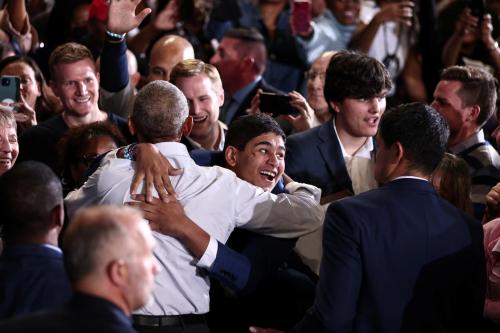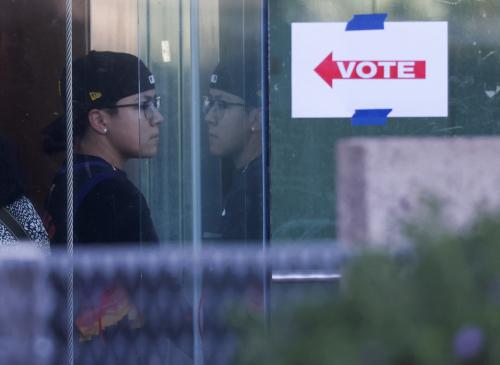In this series we look at how younger voters are likely to impact future elections and American politics going forward.
As we have seen in other articles in these pages, social media has become a key driver of the widening gap in voting behavior between voters over and under 45 years of age. In this article, we look at how the media habits of old and young voters contribute to and enable this gap.
Compared to news delivery systems in the past, news on social media is highly decentralized at its origin and destination. Rather than relying on executives, anchors, and editors to decide what news is fit for consumption, social media places that power directly in the hands of the user. This power allows users to seek out news that interests them and aligns with their concerns, resulting in a fragmented news landscape not defined by political polarization. With this greater access to personalized news feeds comes greater diversity in political perspectives.[1]
According to Pew, over 40% of Americans aged 18-29 say that their primary source of news comes from social media. Twenty-two percent of Americans aged 30-49 say the same. That number plummets to 6% and 3% respectively for those aged 50-64 and 65+. A greater percentage of 18–29-year-olds get their news from social media than 65+ year-olds do from cable news shows.
This remarkable skew between older and younger generations has implications beyond just delivery methods because the experience of getting news from social media differs so drastically from the experience of getting news from legacy media.
Viewership among legacy news outlets (national network and cable news, radio, newspapers, and magazines) splits into two different ecosystems defined by party. Recent Pew research could not find a single news outlet that was watched by a majority of both Democrats and Republicans. Pew was able to identify a number of legacy news sources used almost exclusively by one party.
Social media platforms, by contrast, have users from both parties. The two most popular social media platforms, YouTube and Facebook, are used by the majority of adults in both parties and have almost no partisan split.
 Source: Pew Research Center
Source: Pew Research Center
 Source: Pew Research Center
Source: Pew Research Center
 Source: Pew Research Center
Source: Pew Research Center
There are still some party differences within the social media ecosystem, however. Younger Democrats are more likely to be on every major platform excluding Facebook. Instagram has an especially large gap between parties. But unlike legacy media, what isn’t present in the data is a widely used platform just for Republicans or just for Democrats.[2]
The world of legacy media is bifurcated. The world of social media is fragmented.
The world of legacy media is bifurcated. The world of social media is fragmented.
The social versus traditional news usage patterns hold when looking specifically at those who report getting news from a platform, not just using it.
[3]Although there are differences by party, they are nowhere near the disparities we see in usage patterns by party in legacy media, and no single legacy media outlet approaches the consensus shown in the use of YouTube as a news source.
This is not to say that the experiences of Republicans and Democrats are at all similar on YouTube. A 34-year-old Democrat living in Detroit sees roughly the same thing on NBC News each day as a 68-year-old Republican living in Seattle because the news content is curated by the network, not the user. But a 26-year-old Republican living in Birmingham may have a dramatically different YouTube feed than a 26-year-old Democrat living across the street.
Social media is designed to intentionally fragment user bases into ever narrower groups defined by specific personal interests. A single social media user could belong to a climate change collective on Instagram, an anti-tax Facebook group, and a Southeast Asian cooking community on TikTok. This varied news diet is virtually impossible to receive through legacy media’s bifurcated news landscape.
This same characteristic of hyper-personalized news feeds can lead to echo chambers, which happen when a pocket of like-minded individuals forms and fosters distrust of outside sources. But this same phenomenon of pocket formation is also how Internet fandoms develop — and how BookTok or Black Twitter or a Zelda subreddit forms.
In short, those who get their news from social media have a greater diversity in opinion than those who primarily get their news from legacy media.
Recent survey data from Pew shows how the relationship differences in social media usage by age relates to people’s political ideology. Pew refines political ideology by splitting the public into nine distinct groups: four on the left, four on the right and one with those too uninvolved politically to be classified.
 Source: Pew Research Center
Source: Pew Research Center
Within the four groups that make up consistent Democratic voters, older Democrats are much more likely to cluster in just two of Pew’s typologies — either ‘Democratic Mainstay’ or ‘Establishment Liberal.’[4] Democrats under 50, by contrast, are just as likely to be found in any of the four groups; they have no clear typology preference. As a result, it would be much easier to predict the political ideology of a 53-year-old Democrat chosen at random than a 31-year-old.
[5]To a lesser extent this holds for Republicans as well; however, older Republicans are slightly more varied in their political ideology than their Democratic counterparts. Younger Republicans are slightly less varied in comparison to younger Democrats. A plurality of them is categorized by Pew as being in the ‘Ambivalent Right’ typology. The prevalence of this ideological perspective among younger Republican party identifiers and the lack of young Republicans in traditionally conservative typologies squares with research showing that young Republicans are increasingly at odds with older members of their party.
The Pew political ideology data shows younger voters are driving emerging new wings of both parties. This is happening in the Republican Party with the rise of the ‘Ambivalent Right.’ Among Democrats it’s reflected in the fact that younger voters make up the bulk of those Pew calls the ‘Outsider Left’ and ‘Progressive Left.’ Both phenomena are enabled by the nature of the social media they use as the principal source of news for voters under 50.
Social media allows younger Americans to have more individualized political interests than older voters. They are seeking a political party that will support this diversity of perspectives and welcome their ideas. Whichever one does so through an effective understanding of the social media information ecosystem will enjoy ever increasing electoral success.
Footnotes
[1] This blog does not address the issue of mis/disinformation social media, which is related to news ecosystems, but not directly under the scope of this blog. With users serving as their own editors, mis/disinformation can more easily slip into their news diet, but how this compares to legacy media and how it is driven by partisan forces requires further analysis.
[2] Alt-Right social media sites exist but are currently at such a low level of usage that they don’t impact the overall results.
[3] This data was provided by Pew in a specific crosstab request and is not available on their website data. To view see the following PP_2021.11.09_political-typology_REPORT. Pew did not have specific age breaks on their website, so they created a new document with those breaks for us. For each of the individual social media sites, a respondent is asked if they used a specific site for news information only if they had first indicated that they had ever used that platform.
[4] A value of 20% in the graphs indicates 20% of total Democrats are 50+ and Democratic Mainstays not 20% of Democrats who are 50+ are Democratic Mainstays.
[5] The data used for the graphs is not directly included in Pew’s published work. Pew published the percent of each party in each typology and the percent of each typology who was under 50. We used these two sets of figures to calculate what percent of each party was young and in a specific typology group. This is the data used for the graphs and that data set is included below.
| In a room of 100 Republicans there would be… | ||
| Ages 18-49 | Ages 50+ | |
| Faith and Flag Conserv | 9.316455696 | 19.79746835 |
| Committed Conserv | 8.164556962 | 10.82278481 |
| Populist Right | 12.2278481 | 16.88607595 |
| Ambivalent Right | 14.35443038 | 8.430379747 |
| In a room of 100 Democrats there would be… | ||
| Ages 18-49 | Ages 50+ | |
| Outsider Left | 16.81012658 | 3.443037975 |
| Democratic Mainstays | 15.59493671 | 19.84810127 |
| Establishment Liberals | 15.43037975 | 13.6835443 |
| Progressive Left | 10.78481013 | 4.405063291 |












Commentary
How younger voters will impact elections: How legacy media and social media impact old and young voters
May 15, 2023